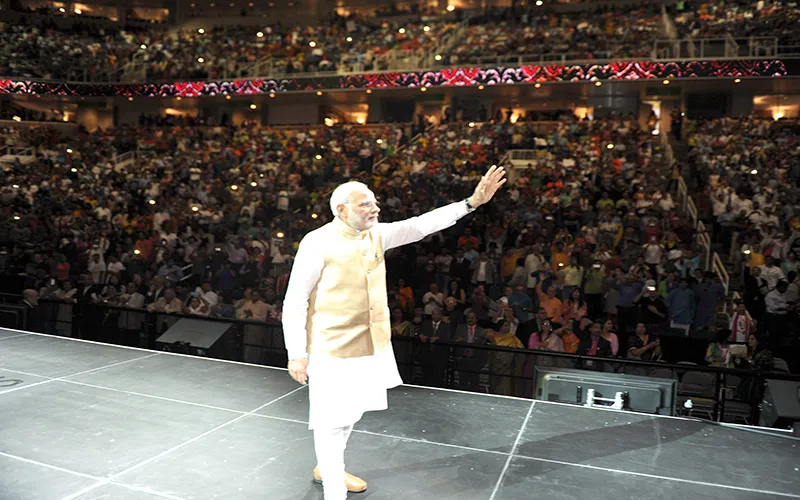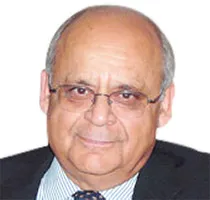-
CENTRES
Progammes & Centres
Location
There was more to Narendra Modi's visit to the US than the razzmatazz of Madison Square Garden and Central Park. He had gone to the US after three basic foreign policy initiatives, and was making a statement on the world stage beyond the confines of the UNGA.

There was more to Narendra Modi's visit to the US than the razzmatazz of Madison Square Garden and Central Park. He had gone to the US after three basic foreign policy initiatives, and was making a statement on the world stage beyond the confines of the United Nations General Assembly (UNGA).
Significantly, his first visits were to the Himalayan countries of Nepal and Bhutan, both bordering Tibet. The immediate neighbourhood has to be peaceful for India's well-being. There were also early Indian interactions with Vietnam and Myanmar.
Japan, Australia, China and the US are the priorities for India's economic and infrastructure growth. Conceivably, Israel and Russia, both essential for our security and technological development, would be next. Narendra Modi has already given an indication with the nature of his interaction with Israeli Prime Minister Netanyahu in New York.
The visit to the US was a kind of a high point in his drive to shake off the old lethargy in India's foreign relations. Clearly the scale of the visit or even the idea of a Modi visit upset many, including the world's only surviving imperialist bastion, the London Economist. The Chinese and the Pakistanis watched it with magnifying glasses and the reactions were as expected.
Narendra Modi's two meetings with the US President, interactions with the entire upper echelons of the US administration and with important corporate heads were enough of an indication of a well-planned visit. There were strategic bilaterals on the sidelines.
The optics were right; India and the US need each other but now comes the hard part. And it is not about dealing with Pakistan, China, Iran, West Asia, Russia, on which the two countries have differing perceptions, or issues like terrorism, on which there is greater consonance. It is about trade and WTO, technology transfers and investments.
India has to be able to deal with the US, a country whose call sign is America First now, accompanied by a somewhat diminished ability to impose both. Slogans for democracy are important for Americans in America, but can be relaxed when dealing with some countries. So also rules of free trade and free speech, where somewhat different US principles and yardsticks come into play when dealing with the rest of the world. The US has had the ability to make domestic laws and make them applicable universally.
Undoubtedly, India must seek closer relations with the strongest power today; there are important areas of mutual concern. Four issues defence supplies, technology transfers (both of which will come with many caveats about guaranteed supplies, end-use and modifications or upgrades), free trade and intellectual property rights will dominate India-US bilateral concerns. All four can be interlinked and are of great concern to American corporate power houses linked closely with the White House and US Senators and Congressmen.
One can see this game already being played in the US in the pharmaceuticals and genetically modified food and seeds sectors. The American system is able to move on all phalanxes simultaneously, to create a climate of opinion in favour of a particular US narrative. Cheaper and equally effective Indian pharmaceutical products threaten expensive US pharmaceutical products in other parts of the world, especially in Africa and Asia, including India.
American pharmaceutical giants have begun a campaign with prominently placed advertisements, opinion pieces, assessments by think tanks and letters to President Obama helped along with interested politicians against Indian pharmaceutical companies. The India-US honeymoon period has barely begun, but there is already a threat handed out that US FDI may not be very forthcoming unless India relaxes its patent laws which would allow even copy-cat products or minor variants of products as it is allowed in the US. At the same time, the notorious US Special 301 annually publishes a list of international offenders of this US law, with threats to impose trade sanctions if their Intellectual Property legislation is not beneficial to US trade.
It seems that India-US relations will be put to test on these issues. Indian pharmaceutical products are one of the biggest earners abroad, although declining in recent years. In its own long-term interests, the industry must campaign using lobbies abroad to explain its case in a manner similar to American tactics in such cases. The government can only help alongside.
So, let us deal with the US willingly and positively on other similar issues of GM seeds and crops, Trade Facilitation Agreement under the WTO, but without tinted glasses and with our eyes wide open without any illusions.
Courtesy: Mid-day
The views expressed above belong to the author(s). ORF research and analyses now available on Telegram! Click here to access our curated content — blogs, longforms and interviews.

Vikram Sood is Advisor at Observer Research Foundation. Mr. Sood is the former head of the Research and Analysis Wing (R&AW) — India’s foreign intelligence agency. ...
Read More +